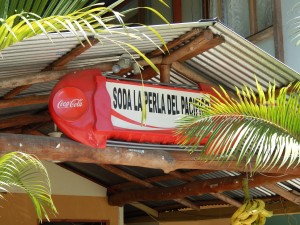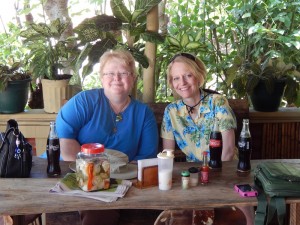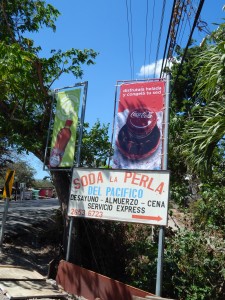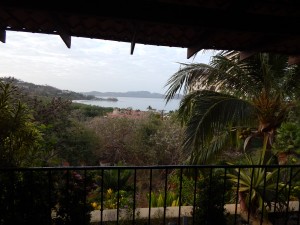
When our son Mark was younger, he and I went on a number of motorcycle trips together that, at one time or another, took us as far south as southern North Carolina, and north through upstate New York into Canada crossing the bridge at Windsor, Ontario and into Detroit. We made it a habit to avoid the chain restaurants and focus on the local eateries along the way. As a result, we discovered some interesting tidbits from local people that we would not otherwise have learned (e.g., how Horseheads, NY got its name). Prior to Heide and I coming to Costa Rica this year, Mark and I were reminiscing about those motorcycle trips. Mark, wise man that he is, said, “Look for a place where the Ticos are lined up and there will be the best food.”
Saturday, I wanted to get away from the tourist areas and experience more authentic Tico cuisine. Here in Playa Flamingo, it seems the majority of Ticos I encounter are service personnel in restaurants. Because tourism is the number one industry in Costa Rica, all of these service folks are “Americanized.” Most speak passable English and, as a result, (USA) Americans are not forced to use the local language. Even many of the restaurant menus contain options like “American Breakfast” with prices in US Dollars ($) rather than the local currency Colones (¢). So it would seem that to come more in contact with the Tico culture and people, we needed to leave our comfort zone.
We decided to have lunch at a soda in Huacas, a small town to the southeast of Playa Flamingo. A soda is a small, inexpensive, family run restaurant in Costa Rica with fare more traditional than the typical tourist restaurants in the area and they are open-air. We ate at the Soda La Perla del Pacifico (The Pearl of the Pacific).
We drove to Huacas and spotted a couple of sodas and decided to try this one. Honestly, from the outside, this is the kind of place you would simply drive by in the USA and never dream of stopping. However, as we entered, I was struck by the sense of pride Gabino (the owner)and his family showed in making us feel welcome. It was like he was inviting us into his living room. Through his broken English and our broken Spanish we got along just fine. His smile was infectious and you couldn’t help but feel like part of the family.
I was particularly impressed with how clean and neat everything was inside the soda. Even though the tables and stools were obviously handmade, unfinished wood and long-used, they were spotlessly clean and there seemed to be a pride about it. Gabino answered our many questions about the menu choices and helped us with the correct pronunciation of words we were mangling in Spanish.

The food was some of the best we have had so far during our stay in Costa Rica and we all had trouble finishing the portion size. It was served with pride. We started a conversation with Gabino’s wife (brief because we just don’t have the vocabulary yet) and she happily waved us into the kitchen. I instinctively grabbed the camera as I got up from the table and, to our surprise, there were three howler monkeys in the tree just outside the kitchen window (bars on the window, of course). The monkeys were just leisurely enjoying their lunch while we were enjoying ours.

The food was delicious, our hosts were gracious and welcoming, the price per meal was just ¢3,300 (about $6.60) for more food than any of us could eat. As you can see in the picture to the left, a good time was had by all.
There is little doubt the weather here is spectacular (even as our hometown is getting 12-18″ of snow dumped it), but immersion in the culture and talking with Ticos is the real gem of Costa Rica.




